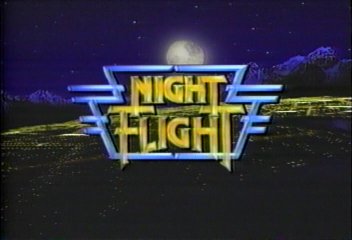I just read Shaun Brady's article over at the AV Club celebrating the eclectic sensibilities of the 1990s show Night Flight, which mashed together a series of music, movie, and assorted other pop culture clips during its Friday and Saturday eight-hour late-night programming blocks. It was sort of like MTV but far more hip and scattershot; as Brady says, "The show might bliss out on a feedback-squalling performance from Neil Young’s Rust Never Sleeps for 20 minutes, smash cut to a re-voiced black-and-white film clip for 2, then settle down for a politically focused discussion with Wendy O. Williams for 10."
It's a fascinating piece, exploring what made Night Flight so entertaining and how, while we've since gained the awesomeness of the internet with everything we could ever possibly want just a few clicks away, we've lost some of the curated weirdness that shows like Night Flight allowed for back in the '80s and '90s. Night Flight and similar shows revealed an alternative world of pop culture to kids everywhere who'd previously only known what they saw in the mainstream culture. If Night Flight sounds to you a lot like falling down the Facebook, Tumblr, or YouTube rabbit holes, you wouldn't be wrong. But the major difference is that while we have a perceived autonomy over our pop culture consumption now to a degree that we never did before, back then you could settle in for an entire evening of unexpected pop culture programming in a way you can't quite do online today. Tumblr might be the closest analogy now, especially if you view a particular page's curated clips and images. The spirit of that past era is still alive online, for sure. But Night Flight was programmed by cultural obsessives who meticulously curated their twice-weekly programming blocks with care and the sort of expertise that can only come from being a cultural obsessive (trust me, I know). Brady's description of what we've lost in the internet age of Spotify and Pandora algorithms is apt:
But algorithms aren’t weird. Cultural obsessives are; they can be elitist or condescending, sure, but they can also make bizarre leaps that aren’t immediately obvious but lead to remarkable, brain-warping discoveries. Where gatekeepers might block you out, there were always tastemakers to sneak you in the side door and show you around: The older sibling who returns from college with a stack of weird new records and movie recommendations; the sarcastic record store clerk who recognizes the seeds of decent taste in your weekly purchases; the cool neighborhood kid whose every arcane utterance sends you scrambling to Google in an attempt to decipher their references.
The article reminded me of something I've been known to bemoan recently, which is that the era of the tastemaker sneaking you in the side door, as Brady puts it, has started to fade. I don't think it'll ever completely go away, instead it's just morphed into different manifestations, but so far it's clear to me that something has been lost. As Brady says:
The challenge to having the same kind of impact today is that Night Flight was a dictatorship, however benevolent, and the whole point of user-oriented sites and services like these are their democratizing effect. Night Flight arrived at a crucial time, as cable TV was still in its infancy but rapidly expanding. USA had been going off the air overnight, so why not hand over the airwaves to a group of midnight-movie experts who knew what audiences responded to in the wee hours? Its time slot became a key aspect of its appeal in a way that’s impossible in today’s “everything, all the time” environment. It was something you stumbled on as you were fading to sleep, or as you came home from a night of imbibing—altered states that made viewers especially susceptible to its heady charms.
There was something special about after hours television in the late twentieth century, right before the dawn of the internet era. Between Night Flight and Up All Night (both from USA Network), to name just two shows, both neophyte and seasoned cultural obsessives alike could devour hours of viewing discoveries every Friday and Saturday night. It was like the old days of pirate radio, in a way, bringing viewers the strange, subversive, and underground elements that couldn't be found in more staid daytime and early evening programming. I was too young to watch Night Flight in its heyday, as its run ended just as I was reaching that perfect age for a show like it, but it was quickly replaced by USA Up All Night, which, along with Joe Bob Briggs' MonsterVision on TNT, became my source for everything from the world of wonderfully bizarre horror and b movies. Along with friends' older brothers, who had already been turning me on to comic books and movies I really wasn't old enough to be watching yet, I furthered my education from the school of cultural obsessives. It was a terrific time to grow up in and I wouldn't trade it for anything. Hopefully as we continue to evolve online we can manage to hang on to or bring back some of that eclectically curated charm that made Night Flight and other shows like it so vital and formative to a generation of cultural obsessives.

Comments
Post a Comment